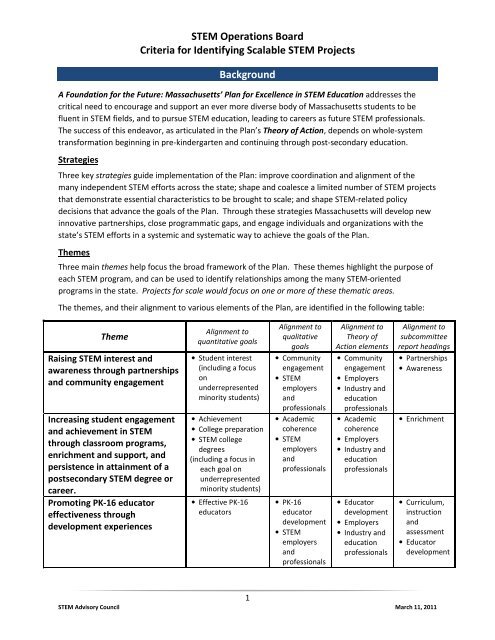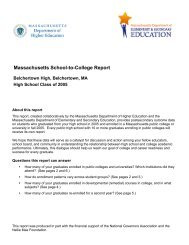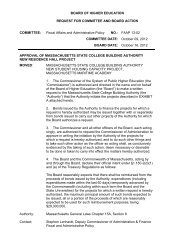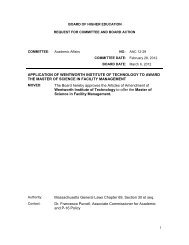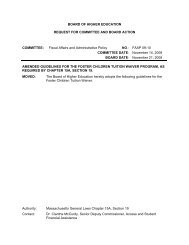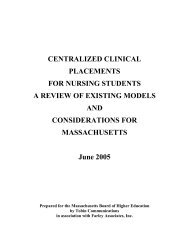Criteria for Identifying Scalable STEM Projects - Massachusetts ...
Criteria for Identifying Scalable STEM Projects - Massachusetts ...
Criteria for Identifying Scalable STEM Projects - Massachusetts ...
You also want an ePaper? Increase the reach of your titles
YUMPU automatically turns print PDFs into web optimized ePapers that Google loves.
<strong>STEM</strong> Operations Board<strong>Criteria</strong> <strong>for</strong> <strong>Identifying</strong> <strong>Scalable</strong> <strong>STEM</strong> <strong>Projects</strong>BackgroundA Foundation <strong>for</strong> the Future: <strong>Massachusetts</strong>’ Plan <strong>for</strong> Excellence in <strong>STEM</strong> Education addresses thecritical need to encourage and support an ever more diverse body of <strong>Massachusetts</strong> students to befluent in <strong>STEM</strong> fields, and to pursue <strong>STEM</strong> education, leading to careers as future <strong>STEM</strong> professionals.The success of this endeavor, as articulated in the Plan’s Theory of Action, depends on whole-systemtrans<strong>for</strong>mation beginning in pre-kindergarten and continuing through post-secondary education.StrategiesThree key strategies guide implementation of the Plan: improve coordination and alignment of themany independent <strong>STEM</strong> ef<strong>for</strong>ts across the state; shape and coalesce a limited number of <strong>STEM</strong> projectsthat demonstrate essential characteristics to be brought to scale; and shape <strong>STEM</strong>-related policydecisions that advance the goals of the Plan. Through these strategies <strong>Massachusetts</strong> will develop newinnovative partnerships, close programmatic gaps, and engage individuals and organizations with thestate’s <strong>STEM</strong> ef<strong>for</strong>ts in a systemic and systematic way to achieve the goals of the Plan.ThemesThree main themes help focus the broad framework of the Plan. These themes highlight the purpose ofeach <strong>STEM</strong> program, and can be used to identify relationships among the many <strong>STEM</strong>-orientedprograms in the state. <strong>Projects</strong> <strong>for</strong> scale would focus on one or more of these thematic areas.The themes, and their alignment to various elements of the Plan, are identified in the following table:ThemeRaising <strong>STEM</strong> interest andawareness through partnershipsand community engagementIncreasing student engagementand achievement in <strong>STEM</strong>through classroom programs,enrichment and support, andpersistence in attainment of apostsecondary <strong>STEM</strong> degree orcareer.Promoting PK-16 educatoreffectiveness throughdevelopment experiencesAlignment toquantitative goals• Student interest(including a focusonunderrepresentedminority students)• Achievement• College preparation• <strong>STEM</strong> collegedegrees(including a focus ineach goal onunderrepresentedminority students)• Effective PK-16educatorsAlignment toqualitativegoals• Communityengagement• <strong>STEM</strong>employersandprofessionals• Academiccoherence• <strong>STEM</strong>employersandprofessionals• PK-16educatordevelopment• <strong>STEM</strong>employersandprofessionalsAlignment toTheory ofAction elements• Communityengagement• Employers• Industry andeducationprofessionals• Academiccoherence• Employers• Industry andeducationprofessionals• Educatordevelopment• Employers• Industry andeducationprofessionalsAlignment tosubcommitteereport headings• Partnerships• Awareness• Enrichment• Curriculum,instructionandassessment• Educatordevelopment1<strong>STEM</strong> Advisory Council March 11, 2011
<strong>STEM</strong> Operations Board<strong>Criteria</strong> <strong>for</strong> <strong>Identifying</strong> <strong>Scalable</strong> <strong>STEM</strong> <strong>Projects</strong>Scale-UpThis document defines the strategy and the criteria <strong>for</strong> scaling up <strong>STEM</strong> projects that have thepotential to create more widespread impact on the goals of the <strong>STEM</strong> Plan.The Operations Board, a subcommittee of the Governor’s <strong>STEM</strong> Advisory Council, proposes thecriteria in the following sections of this document to in<strong>for</strong>m an assessment of projects <strong>for</strong> scaleup(“@Scale projects”). These criteria draw upon:• critical gaps and needs as identified through our analyses of <strong>STEM</strong> themes and state data;• the quantitative goals (Appendix A) defined in the <strong>STEM</strong> Plan;• the qualitative goals (Appendix B) defined in the <strong>STEM</strong> Plan;• research-based characteristics <strong>for</strong> project scale-up;The Operations Board will:• publish this document to in<strong>for</strong>m Regional <strong>STEM</strong> Network and project leaders of the scaleupcriteria;• prioritize crucial themes based on regional or statewide programmatic and partnershipgaps, and in<strong>for</strong>med by analysis of state data;• call <strong>for</strong> applications of projects that address prioritized needs and demonstrate readiness<strong>for</strong> scale-up;• screen applications based on the criteria of this document, and assess a limited number ofprojects that are determined most ready <strong>for</strong> scale-up;• recommend @Scale projects to the Governor’s <strong>STEM</strong> Advisory Council <strong>for</strong> endorsement.The Governor’s <strong>STEM</strong> Advisory Council will identify <strong>STEM</strong> projects to endorse <strong>for</strong> scale-up;project managers can then seek private funding to support scale-up implementation.The following sections define the criteria <strong>for</strong> assessing and identifying @Scale projects.2<strong>STEM</strong> Advisory Council March 11, 2011
<strong>STEM</strong> Operations Board<strong>Criteria</strong> <strong>for</strong> <strong>Identifying</strong> <strong>Scalable</strong> <strong>STEM</strong> <strong>Projects</strong><strong>Criteria</strong> IQuantitative GoalsThe <strong>Massachusetts</strong> <strong>STEM</strong> Plan lists five quantitative goals (see Appendix A <strong>for</strong> more detail):1. Increase student interest in <strong>STEM</strong>2. Increase <strong>STEM</strong> achievement among PreK-12 students3. Increase the percentage of students who demonstrate readiness <strong>for</strong> college-level study in <strong>STEM</strong>fields4. Increase the number of students who graduate from a post-secondary institution with a degreein a <strong>STEM</strong> field5. Increase the number/percentage of PreK-16 <strong>STEM</strong> classes led by effective educators.1) The program must be aligned with at least one of the Plan’s quantitative goals.2) For each of the quantitative goals identified in Item 1, the program must provide evidence ofachievement, or progress toward achievement, of the goal.3) An evaluation process exists which validates the program’s activities as they relate to thequantitative goals.4) Evaluation data must be provided.3<strong>STEM</strong> Advisory Council March 11, 2011
<strong>STEM</strong> Operations Board<strong>Criteria</strong> <strong>for</strong> <strong>Identifying</strong> <strong>Scalable</strong> <strong>STEM</strong> <strong>Projects</strong><strong>Criteria</strong> IIQualitative GoalsThe following four qualitative goals (see Appendix B <strong>for</strong> more detail) drive the Theory of Action of the<strong>Massachusetts</strong> <strong>STEM</strong> Plan:1. Diverse Students and Future <strong>STEM</strong> Professionals2. Community Engagement3. Academic Coherence4. Educator Development1) The program must be aligned with at least one of the Plan’s qualitative goals.2) Current, accepted educational research must validate the program’s approach and methodology toachieving its stated qualitative goal.3) There must be thoughtful consideration of systemic change, in the context of the qualitative goals,that will occur over time as a result of the scale-up of the program.4<strong>STEM</strong> Advisory Council March 11, 2011
<strong>STEM</strong> Operations Board<strong>Criteria</strong> <strong>for</strong> <strong>Identifying</strong> <strong>Scalable</strong> <strong>STEM</strong> <strong>Projects</strong><strong>Criteria</strong> IIIScalabilityAccepted research has shown the following characteristics to be indicators of successful scale-up.1) Users of the program must demonstrate shared ownership of the program. (E.g., educators whohave participated in a Professional Development program, have then applied the learnings to theirpractice.)2) Evidence must exist that the program has caused changes in practice at its present site.3) The program must demonstrate some level of successful scaling since its inception. (e.g., classroom-> classroom)4) The scale-up of the program must have a positive, measurable impact on the Standard (c.f. AppendixA of this document) of each of the goals stated in <strong>Criteria</strong> I Item 1 of this document.5) On a unit basis, the cost per student, or cost per educator, of the scale-out of the program must bereasonable.6) The program must be packaged <strong>for</strong> ease of implementation at an adopting site:a. An “implementation guide” must be available <strong>for</strong> an adopting site.b. Leadership and other resources required <strong>for</strong> successful implementation at an adopting site mustbe identified.7) In order to be in position to “pass the torch”, the host institution / lead partner must:a. demonstrate the capacity and capability to support adopters (e.g., train the trainer);b. be prepared to act as consultant to leadership of an adopting site;c. identify partners who will sustain the program, if the organization itself is not in the business ofdoing so.8) In order to avoid traps and implementation barriers,a. the skills and knowledge necessary to implement the program must be easily transferrable;b. any infrastructure requirements (e.g., technology) necessary to implement the program must beidentified.5<strong>STEM</strong> Advisory Council March 11, 2011
<strong>STEM</strong> Operations Board<strong>Criteria</strong> <strong>for</strong> <strong>Identifying</strong> <strong>Scalable</strong> <strong>STEM</strong> <strong>Projects</strong>Appendix AState <strong>STEM</strong> Plan Quantitative Goals and StandardsThe <strong>Massachusetts</strong> <strong>STEM</strong> Plan lists five quantitative goals:Goal 1: Increase student interest in <strong>STEM</strong>.Standard: Increase interest in <strong>STEM</strong> college majors among college-going MA public schoolgraduates to 35% by 2016 (from 25% in 2009).• Increase interest among the underrepresented gender in fields with a gender-based gapin interest.• Increase interest among underrepresented races/ethnicities in fields with arace/ethnicity-based gap in interest.• Increase interest in fields where there are anticipated gaps in future employment (fromindustry growth and/or from retirement of current employees).• Increase interest in <strong>STEM</strong> fields at early ages (including preschool and elementary school)to assist in increasing student motivation to attain higher levels of <strong>STEM</strong> academicachievement/per<strong>for</strong>mance.Goal 2: Increase <strong>STEM</strong> achievement among PreK-12 students.Standard: Increase the percentage of all students scoring Proficient or Advanced on theMCAS mathematics and science & technology/engineering assessments:• Increase the percentage of all 5 th and 8 th grade students scoring Proficient or Advanced onmathematics and science & technology/engineering MCAS assessments by 20 percentagepoints by 2016.• Increase the percentage of all high school students scoring Proficient or Advanced onmathematics and science & technology/engineering MCAS assessments by 10 percentagepoints by 2016.• Reduce the achievement gaps of 5 th grade, 8 th grade, and high school students on themathematics and science & technology/engineering MCAS assessments by 25% between2010 and 2014, and another 25% between 2014 and 2016.6<strong>STEM</strong> Advisory Council March 11, 2011
<strong>STEM</strong> Operations Board<strong>Criteria</strong> <strong>for</strong> <strong>Identifying</strong> <strong>Scalable</strong> <strong>STEM</strong> <strong>Projects</strong>Appendix AGoal 3: Increase the percentage of students who demonstrate readiness <strong>for</strong> college-levelstudy in <strong>STEM</strong> fields.Standard: Increase the percentage of MA public high school students who report taking at least 4years of math (from 69% in 2009 [SAT]) and 3 years of lab-based science (from 79% in 2009 [SAT]) to100% in 2016, consistent with MassCORE, as well as increase the percentage of MA public highschool students who report taking advanced mathematics (pre-calculus and above) to 55% (from 44%in 2009 [SAT]) by 2016.• Increase <strong>STEM</strong> course-taking among the underrepresented gender in courses with a genderbasedgap in participation.• Increase <strong>STEM</strong> course-taking among underrepresented races/ethnicities in courses with arace/ethnicity-based gap in participation.Goal 4: Increase the number of students who graduate from a post-secondary institution witha degree in a <strong>STEM</strong> field.Standard: Increase the number of students who complete <strong>STEM</strong> post-secondary degrees at MApublic and private institutions by 50% from 2008 to 2016.• Increase the number of Bachelor's degrees granted in all <strong>STEM</strong> majors to all students by 50%by 2016.• Increase the number of Bachelor's degrees granted in all <strong>STEM</strong> majors to theunderrepresented gender in majors with a gender-based gap in degrees.• Increase the number of Bachelor's degrees granted in all <strong>STEM</strong> majors to theunderrepresented gender in majors with a gender-based gap in degrees.Goal 5: Increase the number/percentage of <strong>STEM</strong> classes led by effective educators, fromPreK-16.Standard: TBD`• Future measure of <strong>STEM</strong> qualifications of Pre-K-16 educators (TBD; likely will vary by level:elementary, secondary, post-secondary)• Future measure of <strong>STEM</strong> effectiveness of Pre-K-16 educators (TBD: likely will vary by level:elementary, secondary, post-secondary)7<strong>STEM</strong> Advisory Council March 11, 2011
<strong>STEM</strong> Operations Board<strong>Criteria</strong> <strong>for</strong> <strong>Identifying</strong> <strong>Scalable</strong> <strong>STEM</strong> <strong>Projects</strong>Appendix B State <strong>STEM</strong> Plan Qualitative Goals <strong>for</strong> Trans<strong>for</strong>mationThe following four qualitative goals provide a context <strong>for</strong> the scope of the change and theincreased capacity required to achieve the intended whole-system trans<strong>for</strong>mation.A. Community EngagementEvery <strong>Massachusetts</strong> community will foster increased student interest in <strong>STEM</strong> throughprogramming and spreading awareness. To spark and sustain student awareness of,interest in and motivation to pursue advanced <strong>STEM</strong> education and related careers…• In every community parents, educators, employers, student leaders and <strong>STEM</strong>professionals will be in<strong>for</strong>med and enlisted as advocates to influence, support andsustain student commitment to <strong>STEM</strong> from Pre-K through post-secondary education.• PreK-16 students will have access to rigorous academic and technical preparation inthe <strong>STEM</strong> subjects and be encouraged to engage in experiential and applied learningopportunities.• Collaboration is critical. Effective collaboration can enhance existing opportunities andbolster the development of systems at the community level to engage students atvarious points along the <strong>STEM</strong> pipeline – from preschool to career.B. Academic Coherence<strong>Massachusetts</strong> <strong>STEM</strong> standards, curriculum frameworks, instruction and assessmentswill…• Incorporate a balanced focus on deep content knowledge, mathematical and scientificinquiry and problem solving/design, reflecting post-secondary faculty expectations <strong>for</strong>college and career readiness and employer expectations <strong>for</strong> <strong>STEM</strong> careers.• Align vertically across grade levels and horizontally across subject strands to ensurecoherent subject progressions among schools, across districts and through college.• Connect community-based experiential and project-focused learning resources to PreK-12 curricula and/or through collaborative use of <strong>STEM</strong> related laboratories in thevocational technical schools.8<strong>STEM</strong> Advisory Council March 11, 2011
<strong>STEM</strong> Operations Board<strong>Criteria</strong> <strong>for</strong> <strong>Identifying</strong> <strong>Scalable</strong> <strong>STEM</strong> <strong>Projects</strong>Appendix BC. Educator DevelopmentEvery student will learn from highly effective educators in every <strong>STEM</strong> subject area atevery grade level, PreK-16. <strong>Massachusetts</strong> educators will…• Possess deep subject matter knowledge that spans grade levels; be skilled in thepedagogy of inquiry and problem solving; and be prepared to incorporate experientialand applied learning that integrates science, technology, engineering and mathematicsinto coherent classroom instruction.• Make effective use of technology as a tool <strong>for</strong> learning, recognizing its application as anessential resource <strong>for</strong> every 21 st century <strong>STEM</strong> profession.• Seek out innovative ways to further improve their understanding of their student’sstrengths and weaknesses, through data analysis and the creation of activeassessments.D. <strong>STEM</strong> Employers and <strong>STEM</strong> ProfessionalsEmployers and the community of <strong>STEM</strong> professionals (from industry and education) canprovide an array of opportunities <strong>for</strong> experiential learning, both inside and outside theclassroom by...• Participating in educator professional development and communicating theirexpectations <strong>for</strong> students wishing to pursue a career in their sector. Employers and<strong>STEM</strong> professionals will serve as mentors, internship/co-op supervisors, leaders ofcommunity-based after-school and expanded learning time programs and partner withschools to offer new programming and expand existing programming such as thealready state approved <strong>STEM</strong> programs in vocational technical schools.• Sponsoring university laboratory research and industry-based teacher externships.They will also serve as collaborative partners in high quality professional developmentand pre-service programs.9<strong>STEM</strong> Advisory Council March 11, 2011


